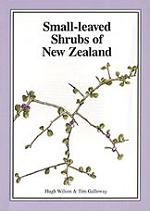
|
Small-leaved
Shrubs of New Zealand Reviewed by Alan Esler At first I wondered if there is a place for one more book about New Zealand shrubs. The subject seems to be well covered, while we are starved of information about many non-woody plants. Did the authors persuade me otherwise in 300 pages with quite a full text, 30 colour illustrations, and 180 line drawings bound between a pair of very solid covers? We have a remarkable number of small-leaved shrubs (and trees) in unrelated families. It is as if a sap-sucking insect injected a gene that made some plants throw anomalies. The introduction to the book does not accept or reject two theories put forward to explain the origin of small-leaved divaricating shrubs, but says they "make good stories". Both may be elements of a complex explanation. Pokaka has a transitory juvenile stage, while in Pseudopanax anomalus the form persists throughout life. In each of these genera only one species is microphyllous. Some native conifers have smaller leaves as adults. To qualify for inclusion in this book the plants had to be between 30 cm and 6 m tall and with leaves less than 2 cm long. This did not exclude trees like rimu which at one stage lie within the limits, or climbers or the occasional alien woody weed. Such a book would be expected to fall into natural sections, and it does: introduction (pp. 1-14), key to species (pp. 15-58), and description of plants (pp. 59-290). This is followed by glossary, references, index, and notes about the authors. Good maps occupy the inside of both covers. The key works: my test samples were named in about 5 minutes each. A user less familiar with keys might do about as well, because there are few technical terms requiring the adequate glossary. In places a hand lens is needed to see some of the plant features clearly. The descriptive part is a mini-flora. It is much more readable than a flora because it does not have to conform to the same conventions. Authority names are not used, and meanings are given for the binomials. None of the common names are continued for the sake of having a vernacular. Most of the descriptions occupy 6 to 8 lines (up to 18) and use words like leaf stalk, petal, stubby, springy, furry, downy which are appropriate terms. Similar plants are compared as a further check on correct naming. About 230 species are covered, 165 in considerable detail. Some genera have numerous small-leaved plants given full treatment Coprosma 33 species, Hebe 22, Olearia 14, and Pittosporum 7. To call them species is not entirely correct; they are distinct entities, but not all have names. The flora covering woody plants published in 1961 is well out of date. One long-retired botanist gives his own tag names "a", "b", "c" and so on to entities he recognised in Coprosma without adequate names, and has used up all the alphabet. There are scores and scores of unnamed plants in our relatively small native flora. Until recently a small team of world-class taxonomists worked to correct this deficiency. Now the team and their internationally known organisation exist no more: such is the state of this fundamental plant science. The standard of naming in the plant trade is appalling, and is not helped by botanists not being able to supply published names for plants that evolved in this country. Hugh Wilson does not resolve these taxonomic deficiencies, but makes us aware of them. In his many publications he has been forced to use descriptions and illustrations to indicate each plant deserving a name. Many 'new species' have been discovered in his intensive vegetation survey of Mt Cook National Park, Stewart Island, and Banks Peninsula. The line drawings are
by Tim Galloway, who has already distinguished himself as an artist
in other publications. Surely, this project must have been the most
demanding. Writing about Coprosma species (p. 83), the
authors say "They are difficult to identify, because not only do
they resemble one another, but the variation within species is considerable,
involving both genetic and environmental factors. In particular,
the difference between plants of a single species growing in shade
and in full sun can be very marked. Nevertheless each species has
its distinctive features, and identification, although challenging,
is far from impossible!" 'Small-leaved shrubs of New Zealand' is more for botanists than for gardeners, but it will take its place in the substantial horticultural literature of the world because many of the plants in the book are used in gardens, and there are prospects for growing many more of them. Horticulture in New Zealand: Journal of the Royal New Zealand Institute of Horticulture 1994 5(1): 36 |
Home | Journal
| Newsletter | Conferences
Awards | Join
RNZIH | RNZIH Directory | Links
© 2000–2026 Royal New Zealand Institute of Horticulture
Last updated: March 1, 2021

 BOOK
REVIEWS
BOOK
REVIEWS